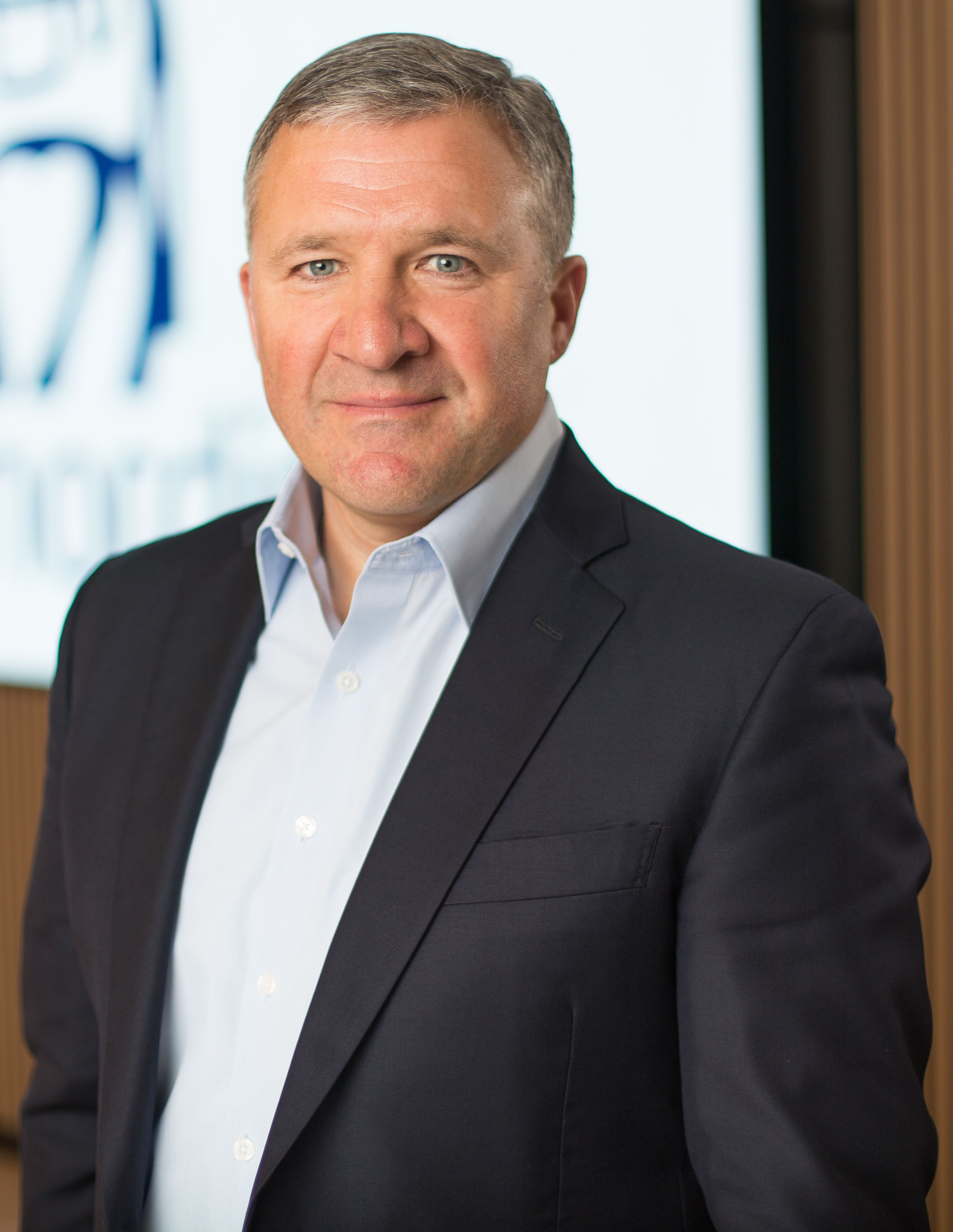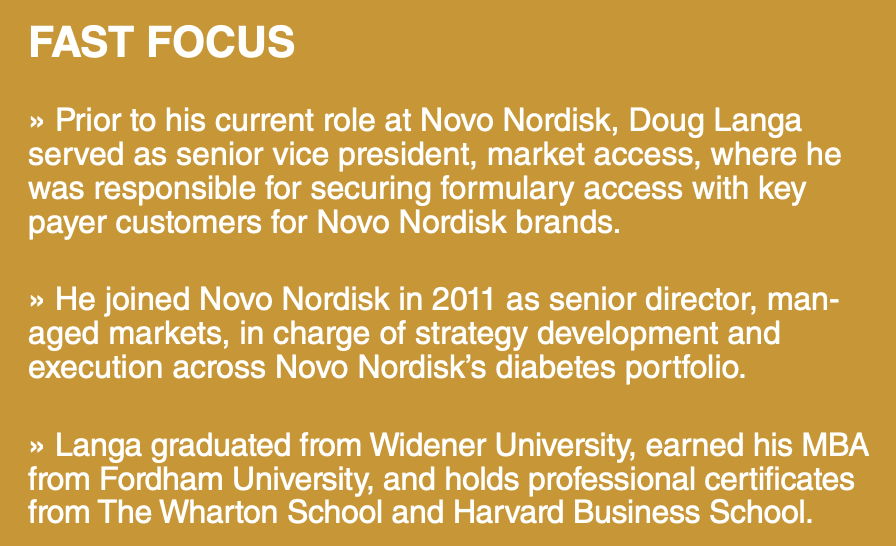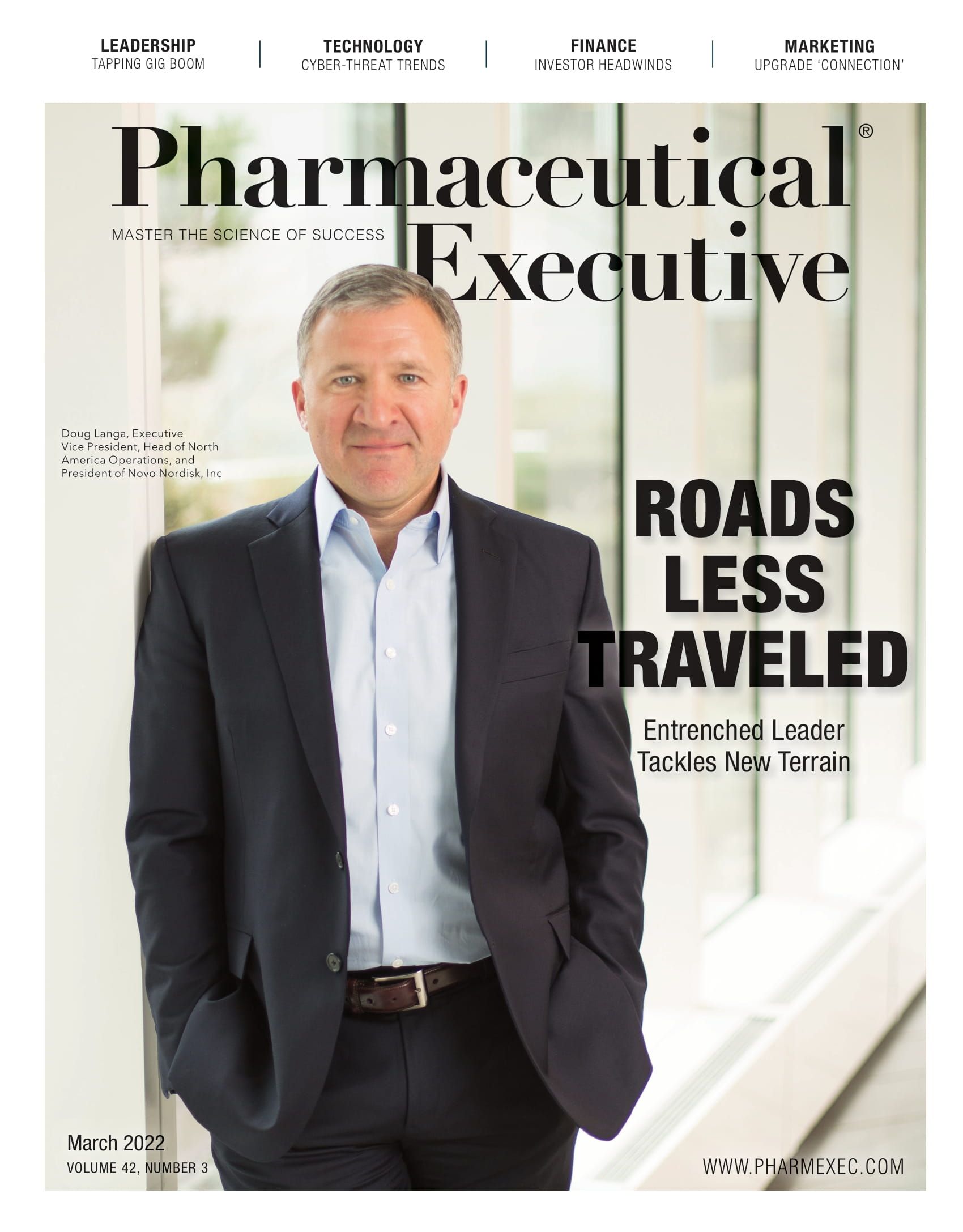- Sustainability
- DE&I
- Pandemic
- Finance
- Legal
- Technology
- Regulatory
- Global
- Pricing
- Strategy
- R&D/Clinical Trials
- Opinion
- Executive Roundtable
- Sales & Marketing
- Executive Profiles
- Leadership
- Market Access
- Patient Engagement
- Supply Chain
- Industry Trends
Roads Less Traveled
After helping lead Novo Nordisk on a transformational journey from a troubled 2016 to double-digit growth in 2021, Doug Langa, Executive Vice President, Head of North America Operations and President of Novo Nordisk, Inc., is calling on his experience of taking the less conventional and sometimes unexpected routes to success to lead Novo Nordisk into new territory.

Taking a position that can satisfy a passion for both sales and healthcare is a pretty standard path for a future pharma leader entering the industry. Doug Langa duly took this route after graduating college and spent the next 18 years (1991–2009) climbing the career ladder in various roles at Johnson and Johnson (J&J). But it was when he moved into market access that something really “clicked” for him. The market access function presented a clearer vision of how the healthcare system works and strengthened his understanding of the patient “table stakes” in terms of getting access to medicines. From that point, Langa would stay in market access—through a subsequent role at GlaxoSmithKline and upon joining Novo Nordisk, Inc. in 2011—until he assumed his current position as Novo Nordisk’s Executive Vice President, Head of North America Operations and President of Novo Nordisk, Inc. in 2017.
Langa had compelling reasons for joining Novo Nordisk, even though it was, he says, a lateral move at the time. He was impressed that the company was owned by the Novo Nordisk Foundation, which is one of the world’s largest independent charitable enterprises. The foundation’s support of scientific, humanitarian, and social causes “resonates through all the companies in the Novo Group and you really feel it,” he says. “Back then, I thought that was really cool, just as I do now.”
The other reason was more personal and more powerful. About a year earlier, his son was diagnosed with growth hormone deficiency. “I thought how great it would be to come to a company that not only has this foundation structure, but also actually manufactures the product that my son needed to get on,” Langa tells Pharm Exec. Novo Nordisk had recently launched a user-friendly injection pen to administer its growth hormone treatment; this was the device that would allow Langa’s young son to inject himself for the first time.
“For a small child to take ownership of their disease—I can’t tell you how much that meant to him and how much that helped him in terms of self-esteem,” says Langa. “It may seem a small thing to some, but the device really impacts patients and their families’ lives. It did for us; it changed my son’s life for the better and it created who he is today.”
Langa believes one of the things that makes Novo Nordisk unique is its commitment to patient centricity. “I think we truly put the patient at the center of all that we do, and that is evident in almost every meeting we have,” he says. Certainly, Langa’s personal experience as the parent of a child with a disease that his company treats has given him an insight that is rare among pharma leaders. It led him to further appreciate and drive “what Novo Nordisk does in terms of the support it gives to patients, parents, and caregivers,” says Langa.
Transformational journey
There is a lot more to Langa’s success at Novo Nordisk than his capacity to empathize with patients and their families, however. When he first took over head of US operations and president of Novo Nordisk, Inc., the business was in decline. Increased pricing pressure from US payers had contributed to the company’s stock falling 18.9% in August 2016. “We’d had a tough year, particularly in the US,” Langa tells Pharm Exec. Langa thus began instigating a “transformational journey,” during which the company had to make “some difficult strategic decisions and trade-offs and take some calculated risks.” He explains, “This was all done with intention of bringing the US back to growth, which is what we achieved.”

Novo Nordisk went from a negative perspective at the end of 2016 to a “flattish, stabilized business” and then to single-digit growth. In 2021, says Langa, “we saw an overall growth of 14% in North America.” He adds: “We haven’t seen growth like that since 2013, so it’s something I’m really proud of.”
The progress of this journey has been all the more remarkable given that it had to advance through COVID-19. The mindset that Langa helped to instill from his first days as the company’s leader seemed to pay off during the pandemic. “When I took on this role, I was committed to building resiliency in the organization because unforeseen things can always happen,” he explains. “There’s a quote from the author Margaret Mead: ‘Never doubt that a small group of thoughtful committed individuals can change the world; indeed, it’s the only thing that ever has.’ When I started, I put that quote on a card, hand-signed it, and sent it out to everyone in the organization. I did that because I really believe we are a small group of thoughtful committed individuals that can change the world.”
A few years later, when COVID hit, “it wasn’t like we were ready for it,” says Langa, “but we did have this resilience.” He explains, “We went through a period of shock like everybody else, but then we said, ‘Right, are we going to handle this?’ Very quickly, our group of committed individuals wanted to get back and do their job. That gave them purpose and meaning amid all the craziness that was happening.”
Novo Nordisk focused on three primary principles to get through the pandemic: “Making sure we can still get medicines to our patients, making sure our employees were safe, and committing to the health agenda.” The company launched two products just before COVID hit—oral diabetes treatment Rybelsus and hemophilia treatment Esperoct—and one during the pandemic, obesity medicine Wegovy. All have been very successful. Initial demand for Wegovy, for example, outstripped its supply and it is on course to be the most successful launch for the company. The company also reports that sales of Rybelsus increased by 190% in the first nine months of 2021.
For Langa, constant communication with the organization was a vital factor in keeping his teams focused on and invested in their work during the disruption. “I was hunkered down in my house for 15 months. I had an iPhone, so I started using it to record and send out videos of support and information to the organization. My wife was the videographer,” he recounts. “In hindsight, I may have sent out too many videos; we even had our pets in some of them. But we wanted the employees to stay connected to the organization, connected with our purpose and the mission that we’re on.”
Risk and reward
That Novo Nordisk mission continues apace. Langa describes the transformation of the last few years as “Chapter One;” now there are new milestones to reach: “Chapter Two.” The company’s 100 years of heritage is “super important to us and to me,” says Langa, “but one of the things I want to do is continue to modernize the organization and be forward-looking. I’ve never wanted to change things for change’s sake, but I do try to do things differently and be progressive.” Indeed, while Langa has proved himself a solid, consistent, and familial leader, he has never been averse to risk-taking.
His career has in fact been built on taking calculated risks and making lateral moves. For example, as the company was progressing through its transformation and set to launch diabetes treatment Ozempic in early 2019, Langa championed an effort to change the operating model, which he says was met with some hesitancy. “Why would we want to change the way we launched a product?” he says. “But I really, truly believed it was important to do this and that it would be successful. If you have this belief and you’ve done your homework, sometimes you have to jump out of the plane and believe the parachute is going to open. And in this case, it did. It has been one of the most successful launches we’ve had.”
Langa points to another example, early in his career when he was working in medical devices at J&J. He was asked by the president of one division to help manage a company that was going to be sold in two years’ time. “The idea was I would help to get the company into good shape to sell, but then I’d be out of a job. So, I called a trusted mentor who said, ‘Take the role; you’re going to learn more in those two years than you would in any other job.’ Sure enough, two years on, the company was sold and I lost my job in devices. But then I landed in the pharma sector and that led me to where I am today.” Having started his career “always trying to point myself in an upwards direction,” Langa realized that “the experiences you get from your roles can be more important than the direction in which you’re headed.”
Langa’s history of taking less conventional or even unexpected pathways to reach desired goals will be essential in steering the company through the territory that lies ahead. While Novo Nordisk has been recognized primarily as a diabetes company over the last 100 years, it is now advancing into new therapy areas, starting with nonalcoholic steatohepatitis (NASH), chronic kidney disease, cardiovascular disease in the US, and Alzheimer’s disease. Beyond that, Langa says propitiously, “a significant portion of our growth will come from areas that we don’t even participate in today.” This second chapter will see an evolution of the business, continuing in its long-established therapy areas but also venturing into new ones. And, as with chapter one, he says, “we’re going to have to flex some new muscles, learn some new skills, and take some more calculated risks in the process.”
As Langa reminds us, however, pharma is a risk-based business to begin with. “Just look at what it takes to get a product to market. Clinical trials are inherently risky,” he says. “Working out how we can be better and how we can be more successful involves risk. There are risks to the acquisitions we make.” Langa adds, “So, yes, I’ll be taking some more risks. I’ve no doubt the second chapter will lead to a few more.”
Julian Upton is Pharm Exec’s European and Online Editor. He can be reached at jupton@mjhlifesciences.com.

